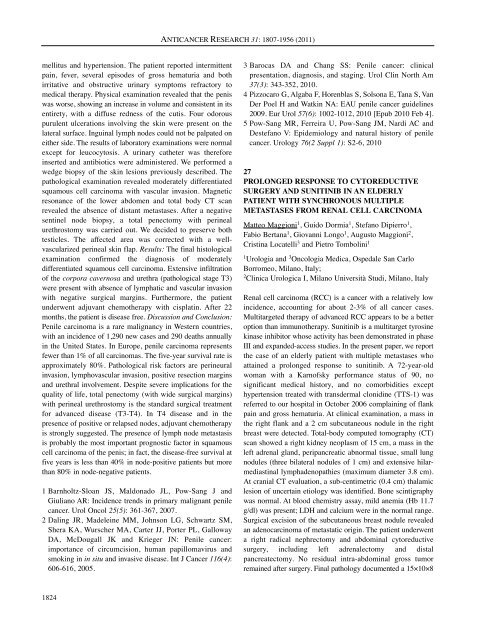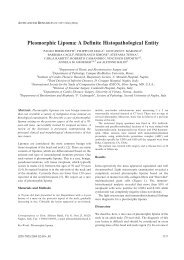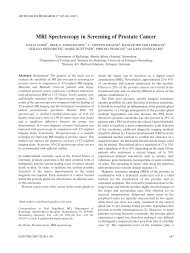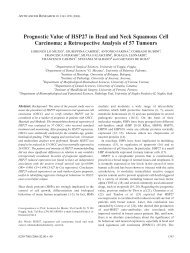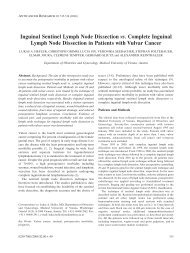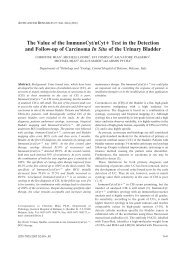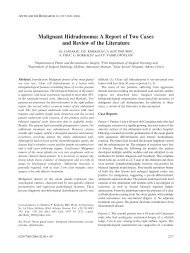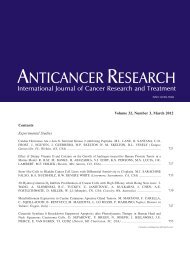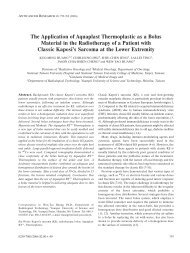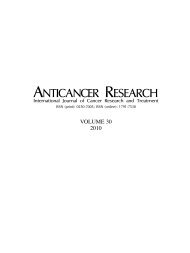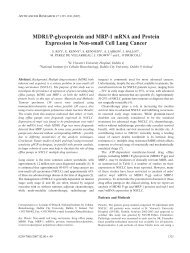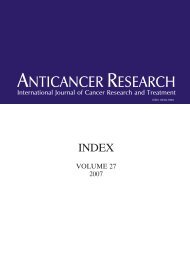ABSTRACTS OF THE 21st ANNUAL MEETING OF THE ITALIAN ...
ABSTRACTS OF THE 21st ANNUAL MEETING OF THE ITALIAN ...
ABSTRACTS OF THE 21st ANNUAL MEETING OF THE ITALIAN ...
You also want an ePaper? Increase the reach of your titles
YUMPU automatically turns print PDFs into web optimized ePapers that Google loves.
mellitus and hypertension. The patient reported intermittent<br />
pain, fever, several episodes of gross hematuria and both<br />
irritative and obstructive urinary symptoms refractory to<br />
medical therapy. Physical examination revealed that the penis<br />
was worse, showing an increase in volume and consistent in its<br />
entirety, with a diffuse redness of the cutis. Four odorous<br />
purulent ulcerations involving the skin were present on the<br />
lateral surface. Inguinal lymph nodes could not be palpated on<br />
either side. The results of laboratory examinations were normal<br />
except for leucocytosis. A urinary catheter was therefore<br />
inserted and antibiotics were administered. We performed a<br />
wedge biopsy of the skin lesions previously described. The<br />
pathological examination revealed moderately differentiated<br />
squamous cell carcinoma with vascular invasion. Magnetic<br />
resonance of the lower abdomen and total body CT scan<br />
revealed the absence of distant metastases. After a negative<br />
sentinel node biopsy, a total penectomy with perineal<br />
urethrostomy was carried out. We decided to preserve both<br />
testicles. The affected area was corrected with a wellvascularized<br />
perineal skin flap. Results: The final histological<br />
examination confirmed the diagnosis of moderately<br />
differentiated squamous cell carcinoma. Extensive infiltration<br />
of the corpora cavernosa and urethra (pathological stage T3)<br />
were present with absence of lymphatic and vascular invasion<br />
with negative surgical margins. Furthermore, the patient<br />
underwent adjuvant chemotherapy with cisplatin. After 22<br />
months, the patient is disease free. Discussion and Conclusion:<br />
Penile carcinoma is a rare malignancy in Western countries,<br />
with an incidence of 1,290 new cases and 290 deaths annually<br />
in the United States. In Europe, penile carcinoma represents<br />
fewer than 1% of all carcinomas. The five-year survival rate is<br />
approximately 80%. Pathological risk factors are perineural<br />
invasion, lymphovascular invasion, positive resection margins<br />
and urethral involvement. Despite severe implications for the<br />
quality of life, total penectomy (with wide surgical margins)<br />
with perineal urethrostomy is the standard surgical treatment<br />
for advanced disease (T3-T4). In T4 disease and in the<br />
presence of positive or relapsed nodes, adjuvant chemotherapy<br />
is strongly suggested. The presence of lymph node metastasis<br />
is probably the most important prognostic factor in squamous<br />
cell carcinoma of the penis; in fact, the disease-free survival at<br />
five years is less than 40% in node-positive patients but more<br />
than 80% in node-negative patients.<br />
1 Barnholtz-Sloan JS, Maldonado JL, Pow-Sang J and<br />
Giuliano AR: Incidence trends in primary malignant penile<br />
cancer. Urol Oncol 25(5): 361-367, 2007.<br />
2 Daling JR, Madeleine MM, Johnson LG, Schwartz SM,<br />
Shera KA, Wurscher MA, Carter JJ, Porter PL, Galloway<br />
DA, McDougall JK and Krieger JN: Penile cancer:<br />
importance of circumcision, human papillomavirus and<br />
smoking in in situ and invasive disease. Int J Cancer 116(4):<br />
606-616, 2005.<br />
1824<br />
ANTICANCER RESEARCH 31: 1807-1956 (2011)<br />
3 Barocas DA and Chang SS: Penile cancer: clinical<br />
presentation, diagnosis, and staging. Urol Clin North Am<br />
37(3): 343-352, 2010.<br />
4 Pizzocaro G, Algaba F, Horenblas S, Solsona E, Tana S, Van<br />
Der Poel H and Watkin NA: EAU penile cancer guidelines<br />
2009. Eur Urol 57(6): 1002-1012, 2010 [Epub 2010 Feb 4].<br />
5 Pow-Sang MR, Ferreira U, Pow-Sang JM, Nardi AC and<br />
Destefano V: Epidemiology and natural history of penile<br />
cancer. Urology 76(2 Suppl 1): S2-6, 2010<br />
27<br />
PROLONGED RESPONSE TO CYTOREDUCTIVE<br />
SURGERY AND SUNITINIB IN AN ELDERLY<br />
PATIENT WITH SYNCHRONOUS MULTIPLE<br />
METASTASES FROM RENAL CELL CARCINOMA<br />
Matteo Maggioni1 , Guido Dormia1 , Stefano Dipierro1 ,<br />
Fabio Bertana1 , Giovanni Longo1 , Augusto Maggioni2 ,<br />
Cristina Locatelli3 and Pietro Tombolini1 1Urologia and 3Oncologia Medica, Ospedale San Carlo<br />
Borromeo, Milano, Italy;<br />
2Clinica Urologica I, Milano Università Studi, Milano, Italy<br />
Renal cell carcinoma (RCC) is a cancer with a relatively low<br />
incidence, accounting for about 2-3% of all cancer cases.<br />
Multitargeted therapy of advanced RCC appears to be a better<br />
option than immunotherapy. Sunitinib is a multitarget tyrosine<br />
kinase inhibitor whose activity has been demonstrated in phase<br />
III and expanded-access studies. In the present paper, we report<br />
the case of an elderly patient with multiple metastases who<br />
attained a prolonged response to sunitinib. A 72-year-old<br />
woman with a Karnofsky performance status of 90, no<br />
significant medical history, and no comorbidities except<br />
hypertension treated with transdermal clonidine (TTS-1) was<br />
referred to our hospital in October 2006 complaining of flank<br />
pain and gross hematuria. At clinical examination, a mass in<br />
the right flank and a 2 cm subcutaneous nodule in the right<br />
breast were detected. Total-body computed tomography (CT)<br />
scan showed a right kidney neoplasm of 15 cm, a mass in the<br />
left adrenal gland, peripancreatic abnormal tissue, small lung<br />
nodules (three bilateral nodules of 1 cm) and extensive hilarmediastinal<br />
lymphadenopathies (maximum diameter 3.8 cm).<br />
At cranial CT evaluation, a sub-centimetric (0.4 cm) thalamic<br />
lesion of uncertain etiology was identified. Bone scintigraphy<br />
was normal. At blood chemistry assay, mild anemia (Hb 11.7<br />
g/dl) was present; LDH and calcium were in the normal range.<br />
Surgical excision of the subcutaneous breast nodule revealed<br />
an adenocarcinoma of metastatic origin. The patient underwent<br />
a right radical nephrectomy and abdominal cytoreductive<br />
surgery, including left adrenalectomy and distal<br />
pancreatectomy. No residual intra-abdominal gross tumor<br />
remained after surgery. Final pathology documented a 15×10×8


